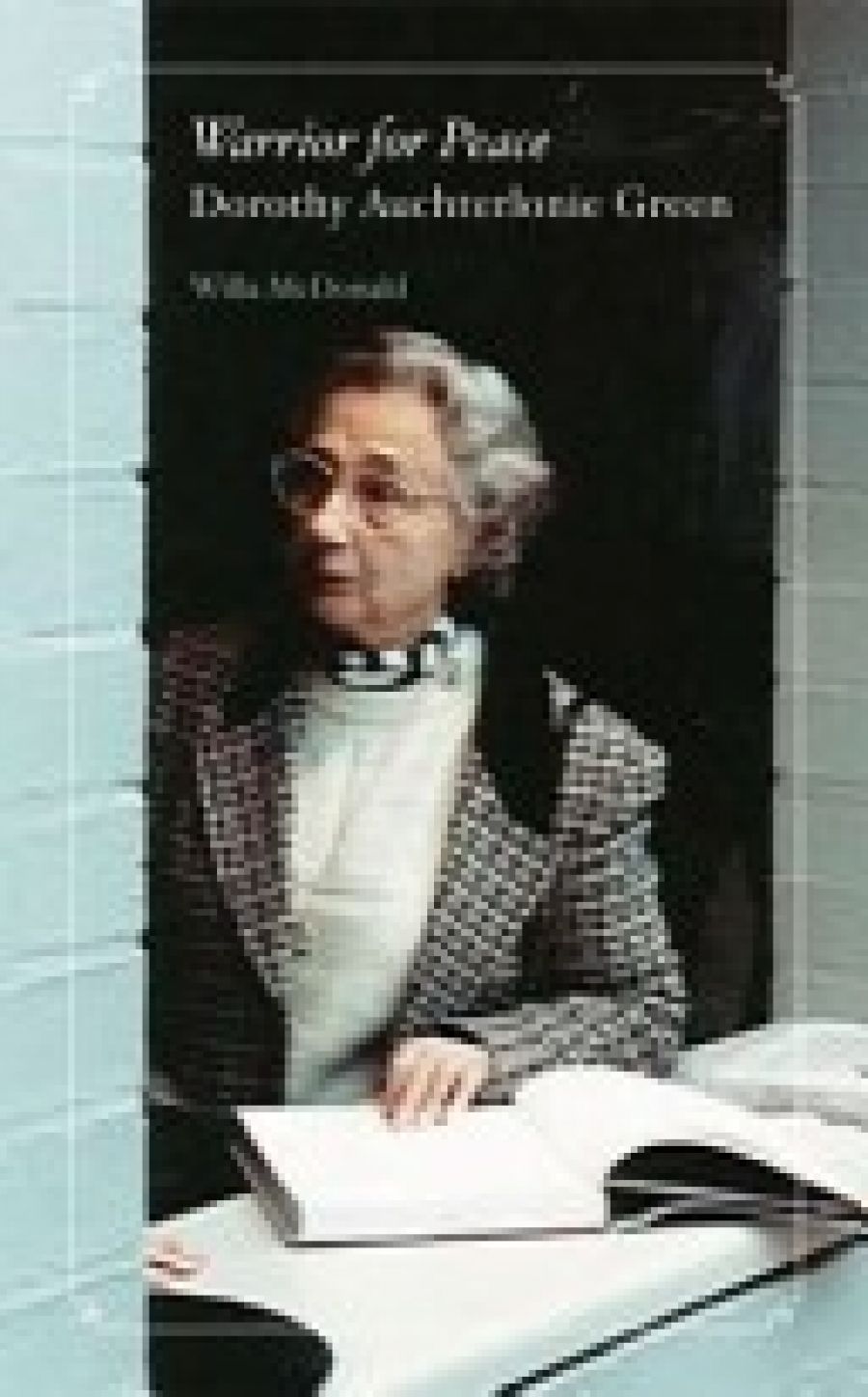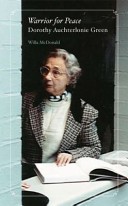
- Free Article: No
- Contents Category: Biography
- Review Article: Yes
- Article Title: Fierce compassion
- Online Only: No
- Custom Highlight Text:
[I]magine that a dictator had decreed that all publications in the future must be signed ‘Anon’, on pain of imprisonment. This would clear the ground of all but the most dedicated and necessary authors, allow trees to breathe more freely, and diminish the carbon imbalance. It is worth thinking about.
- Book 1 Title: Warrior For Peace
- Book 1 Subtitle: Dorothy Auchterlonie Green
- Book 1 Biblio: Australian Scholarly Publishing, $44 pb, 247 pp
- Book 1 Cover Small (400 x 600):

One of the strengths of Willa McDonald’s very readable biography lies in how she presents Green’s foibles and contradictions alongside her considerable intelligence and principled action. That her contradictions were productive is signalled in the title itself, Warrior for Peace, a phrase that also cues us to the book’s main focus. Eleven of McDonald’s seventeen chapters concern the last two decades of Green’s life when, beyond anti-Vietnam protests, she contributed her profile, energies and talents to the causes of peace, disarmament and the environment. Compared with this, the importance of Green’s life and work as teacher, scholar, poet and literary critic – established in the first seven chapters – tends to recede. There is only limited attention given, for instance, to her major critical study, Ulysses Bound: Henry Handel Richardson and her fiction (1973).
Though McDonald does not attempt a more exhaustive analysis of Green’s literary impact and legacy, this decision can be justified on two counts. Firstly, given her social conscience, Green would surely have approved. Secondly, it seems sensible to have prioritised documentation of Green’s activism, since her own writings can speak for themselves. Yet this does leave room for others to ‘weigh and consider’ (as she put it, referring to Francis Bacon in her essay ‘The Reader’) what difference she made to Australian literature as a field of study. Green is of special interest as a threshold figure who contributed to the field’s emergence as a university discipline while practising what we now seem less capable of: the communication of scholarly literary knowledge beyond the academy.
McDonald’s opening chapters engagingly sketch her intellectual formation, beliefs and personality. These prove integral to the account of Green as a fully fledged ‘social critic’. The details, spare at times, are sufficiently telling: Dorothy’s thwarted musical aspirations, the influence of free-thinker John Anderson, her friendship with Harold Stewart, her association with Meanjin and the Christesens, her work at the ABC and her unconventional marriage to the much older literary historian H.M. Green, on whose two-volume History of Australian Literature: Pure and Applied (1961) Green laboured so assiduously.
McDonald illuminates how Christianity shaped Green’s values, particularly her devotion to caritas, understood as ‘fierce compassion’. Though conservative, this background formed an intellectual and moral basis for resisting bigotry and corruption. Fierce compassion shone through Green’s work as co-principal with Betty Crombie at the Presbyterian Girls’ College, in Warwick, Queensland. The women’s collaborative effort to nourish their students’ intellectual curiosity and passion for learning makes inspiring reading for those who believe in the inter-dependence of teaching and research, despite the pressures of increasingly resource-starved humanities departments in today’s universities. This interlude sets a pattern repeated across a career marked by generous service, intellectual commitment and inspiring, if combative, leadership.
Green appears, in various contexts, as both conservative and radical; as a woman of principle, shaped by, but in contention with, her times. Like other women of her generation, she had to hold her own in male-dominated bastions. Even so, without being fully aware of it, she seemed partly caught up in masculinist ways of thinking. She suffered from lack of recognition by the academy: it was not, McDonald observes, until she retired from her university post that her reputation as a public critic really flourished. Yet while Green’s career was limited by institutional and ideological structures of gender inequality, it was also enriched by the diversity of her experiences.
The eleven chapters about her peace campaigning tell us much about Green herself, but also reveal something of the quotidian history of that period’s activism. Like Judith Wright and Patrick White, Green engaged with a spectrum of anti-war and environmental groups in which new political alliances were being forged, cutting across old left and right formations. I found McDonald’s account, which could so easily have been mired in trivia, deftly handled, with suitably lively attention to debates circulating through these networks about the relationship between writing and activism.
McDonald prepares the reader to appreciate the logic and value of Green’s sympathy for the otherwise quixotic campaign to make Australia a neutral nation. More contentious was her advocacy of Writers for an Ecologically Sustainable Population (WESP), which led in 1989 to controversy in the pages of The Australian, Australian Author and ABR (July and November 1989) about population policy and multiculturalism. Certain vignettes – such as the friction observed between Green and Oodgeroo Noonuccal at a high-level Moscow peace conference – are suggestive, though thankfully McDonald resists over-interpretation. Such episodes hint at the prevalence of white settler norms in Australia’s progressive movements. Yet personality and politics are often inseparable: Green’s unease with Oodgeroo be-speaks the clash of two strong-minded women, or merely confirms Mc-Donald’s earlier observation about the brittle quality of Green’s strength.
The portrait that emerges from McDonald’s book coheres well with the voice that rings through Green’s writing: witty, intelligent, forthright, courageous, caustic towards fools and opponents, unstinting in advocating her beliefs, and energetic in her concern for Australia and for a world threatened with extinction. What stays with me, though, is Green’s rigour in probing the role of literature in public life, even as she agitated for its social value. Her belief in the centrality of language and the imagination continues to impress. And if, as McDonald suggests, Green’s definitive turn of mind limited the calibre of her own poetry, this is precisely what made her an effective public communicator and critic, someone who gave praise where it was due and who challenged dominant paradigms and power élites.
Green was that rarity: an opinionated literary intellectual oriented to a broad public, a critic who participated in key cultural institutions of civic life: the media, schools and the academy. If in the digital age she seems outmoded, in other ways hers is a freshly relevant figure. McDonald’s biography is a good read and recalls Dorothy Green with appropriate respect and critical insight.


Comments powered by CComment